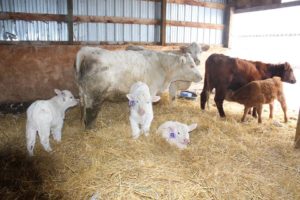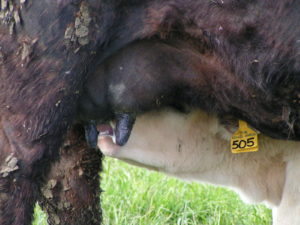Preventing Scour In Calves
26 February 2018In some herds, scour can be a significant cause of illness and death in young calves. The pathogens which cause scour are present in every herd, but not every herd will experience disease associated with them. This is because there is much which can be done to limit their impact.
Colostrum Management
Making sure calves suckle and absorb colostrum is important. The antibodies in the colostrum can bind to bacteria and viruses in the gut, and can also provide protection should the pathogens invade. For calves born outside this can be challenging to ensure this happens, but herds which calve inside should be able to assess whether this has occurred.
Calves which have a difficult calving, or are dopey and have a weak suck reflex after birth, tend not to absorb colostrum well. In these cases colostrum should be given to the calf by stomach tube or bottle. Some dopey calves will be acidotic – they have had a build up of acid due to a lack of oxygen. These calves won’t absorb colostrum well even if it is given, and in these cases it may be necessary for your vet to give an injection of bicarbonate into the vein.
Vaccinations against rotavirus, coronavirus and certain types of E.coli infection can be given to the dam between 3 and 12 weeks prior to calving. This provides some protection against these infections, and reduces shedding. The protection is transferred to the calf via the colostrum, so for this to have any effect, good colostrum management is essential. Having a relatively accurate calving date is also important for using this vaccine. Vaccines work best when the calf’s immune system is not exposed to excessive numbers of the bacteria or viruses, and so reducing exposure is important alongside vaccination.
Calving and Calf Environment
 Maintaining a tight spread of calving can reduce the number of cases of diarrhoea. This is because infection tends to build up in the environment as calving progresses, and so the later born calves have much more of a challenge than the ones born earlier. Calves born in the last half of a fifteen week calving period were found to be 8 times more likely to die than those born in the first half.
Maintaining a tight spread of calving can reduce the number of cases of diarrhoea. This is because infection tends to build up in the environment as calving progresses, and so the later born calves have much more of a challenge than the ones born earlier. Calves born in the last half of a fifteen week calving period were found to be 8 times more likely to die than those born in the first half.
To identify control measures in this area, we need to look at where the calves acquire the bacteria and viruses from. There are four sources – adult cattle, healthy older calves, calves with diarrhoea or which have recovered from diarrhoea and the environment.
Maintaining as clean an environment as possible is crucial for calves kept inside. For calves kept outside, it can be useful to consider how calves are grouped.
A project called the Sandhills calving system explored this concept. Once calving had started they moved pregnant cows every 1 – 2 weeks. This had two benefits:
- Young calves were not exposed to older calves, which can be immune to the infections, but still shed the bacteria and viruses
- There was less of a build up of infection on the ground
In a 800 – 900 cow herd which trialled this, in the five years previous to starting this system, had calf losses due to scour of between 55 and 120 calves a year. In the three years after the introduction of this system, no calves were lost due to scour, and only four were treated. They experienced a 24-fold reduction in veterinary expense, with more calves weaned.
Although this system was designed for use at grass, similar systems can be used in young housed calves. Being careful not to mix calves which are far apart in age is important. How narrow an age range can be achieved depends on the size of the herd, calving spread and buildings available.
Calves with scour, or which have recently scoured, shed huge numbers of bacteria or viruses. Having an area where these calves can be quarantined will limit the spread of infection, and the number of calves affected.
Katrina Henderson, katrina.henderson@sac.co.uk
Sign up to the FAS newsletter
Receive updates on news, events and publications from Scotland’s Farm Advisory Service

